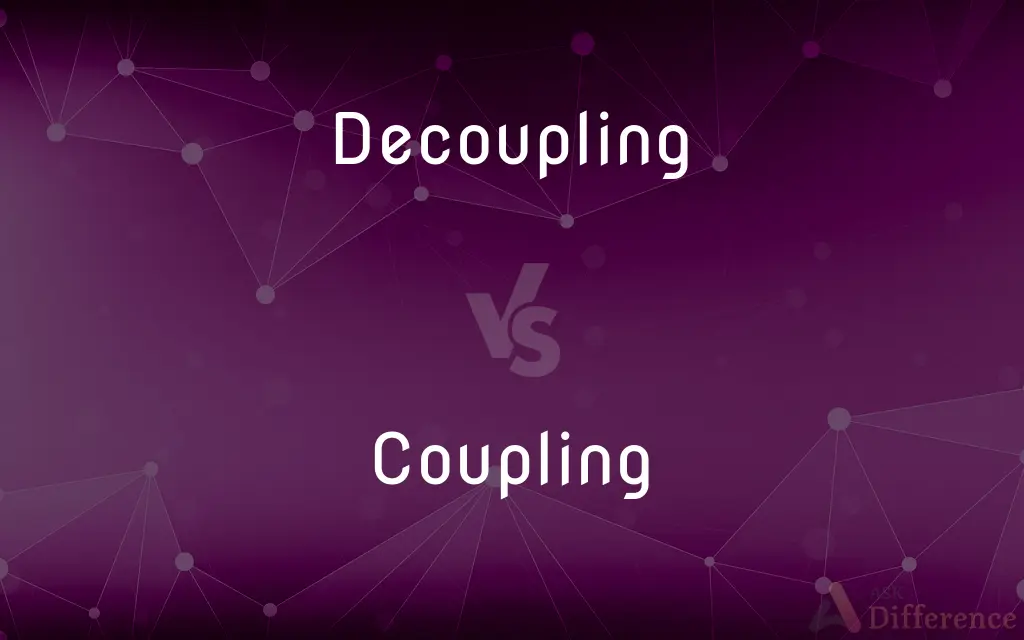Decoupling vs. Coupling — What's the Difference?
Edited by Tayyaba Rehman — By Urooj Arif — Updated on April 15, 2024
Decoupling minimizes dependencies, enhancing module isolation and system adaptability. While coupling refers to the degree of interdependence between software modules, potentially reducing flexibility and maintainability.

Difference Between Decoupling and Coupling
Table of Contents
ADVERTISEMENT
Key Differences
Decoupling involves separating these modules to reduce their interdependencies, aiming to make each module more independent and easier to manage. Whereas Coupling in software design indicates how closely connected different modules or components are within a system, which can affect the ease of modification and testing.
High coupling can lead to systems where changes in one module necessitate changes in others, potentially increasing the risk of errors and complicating updates. On the other hand, a decoupled system allows for modules to be modified or replaced with minimal impact on other parts of the system.
Coupling can be necessary for achieving specific functionality where components need to interact closely, but excessive coupling can restrict the flexibility of the system. Conversely, effective decoupling often employs interfaces or design patterns like the Observer or Mediator to manage interactions, preserving system flexibility.
In terms of testing, highly coupled systems may require more complex and extensive testing strategies, as changes in one module could affect several others. Decoupled systems, however, facilitate more straightforward, module-specific testing, which can be more efficient and less costly.
While coupling might facilitate certain types of coordination between closely related modules, decoupling enhances the scalability of a system by enabling individual components to evolve independently, often making the system more robust and easier to extend.
ADVERTISEMENT
Comparison Chart
Dependencies
Low inter-module dependencies.
High inter-module dependencies.
System Flexibility
Increased, allowing independent module modification.
Reduced, as changes in one module affect others.
Ease of Testing
Simplified, enabling independent component testing.
More complex due to interconnected components.
Design Approach
Utilizes interfaces or design patterns for interaction.
Often involves direct interactions between components.
Scalability
Enhanced by independent module functionality.
Potentially limited by intertwined module functionality.
Compare with Definitions
Decoupling
The process of reducing dependencies between system modules to increase modularity.
Decoupling the user interface from business logic allows easier redesign without affecting backend processes.
Coupling
Typically results in a system where components are not easily separable.
The tightly coupled architecture complicates both testing and maintenance.
Decoupling
Often involves using patterns or interfaces to facilitate communication indirectly.
Implementing a message queue decouples the transaction processing from the billing system.
Coupling
Often requires more careful management to prevent issues in maintainability.
The development team is addressing high coupling to ease future upgrades.
Decoupling
Helps in scaling systems by isolating changes to specific modules.
Thanks to decoupling, adding new features does not disrupt existing functionality.
Coupling
Can refer to the level of direct knowledge that one component has of another.
Due to high coupling, changing the database schema required adjustments in multiple backend services.
Decoupling
Enhances the ability to test modules in isolation from others.
Decoupling allows developers to perform unit tests on individual modules without complex setups.
Coupling
Can be classified as low, medium, or high, affecting system robustness.
We aim to reduce coupling to improve system resilience.
Decoupling
Aims to make individual components more independently operable.
Decoupled components can be updated or replaced with minimal impact on the overall system.
Coupling
The measure of how closely connected different components or modules are within a software system.
Tight coupling in the legacy system made it hard to introduce new features.
Decoupling
(Electronics) To reduce or eliminate the coupling of (one circuit or part to another).
Coupling
A coupling is a device used to connect two shafts together at their ends for the purpose of transmitting power. The primary purpose of couplings is to join two pieces of rotating equipment while permitting some degree of misalignment or end movement or both.
Decoupling
(Physics) To decrease or eliminate airborne shock waves from (an explosion) by having it take place underground.
Coupling
The act of linking together or forming couples.
Decoupling
To separate or detach
"Bipeds have a potential advantage over quadrupeds in decoupling their breathing from their locomotion" (Craig Stanford).
Coupling
A device that links or connects.
Decoupling
Present participle of decouple
Coupling
(Electronics) The transfer of electricity from one circuit to another.
Decoupling
The act or process by which something is decoupled.
Coupling
(Chemistry) Facilitation or acceleration of one chemical process due to the presence or action of another.
Coupling
The body part of a four-footed animal that connects the hindquarters to the forequarters.
Coupling
Act of joining together to form a couple.
Coupling
A device that couples two things together.
Coupling
(software engineering) The degree of reliance between two or more software modules.
Coupling
(electronics) A connection between two electronic circuits such that a signal can pass between them.
Coupling
(physics) The property of physical systems that they are interacting with each other
Coupling
Present participle of couple
Coupling
A device or contrivance which serves to couple or connect adjacent parts or objects; as, a belt coupling, which connects the ends of a belt; a car coupling, which connects the cars in a train; a shaft coupling, which connects the ends of shafts.
Coupling
A connection (like a clamp or vise) between two things so they move together
Coupling
A mechanical device that serves to connect the ends of adjacent objects
Coupling
The act of pairing a male and female for reproductive purposes;
The casual couplings of adolescents
The mating of some species occurs only in the spring
Common Curiosities
Can too much decoupling be a problem?
Excessive decoupling can lead to overly complex systems where the integration and coordination of components become cumbersome.
How does coupling affect system testing?
Tight coupling complicates testing because it requires considering the integrated functioning of multiple components, often necessitating extensive integration tests.
Why is decoupling considered beneficial in software development?
Decoupling is beneficial because it enhances flexibility, maintainability, and scalability, making systems easier to manage and evolve.
What is an example of high coupling in software systems?
High coupling is evident when a change to a database layout forces changes in multiple consuming services that directly query it.
What measures can be taken to reduce coupling in an existing system?
Introducing abstraction layers, using service interfaces, and applying design patterns are common measures to reduce coupling.
What design patterns promote decoupling?
Design patterns like the Observer, Mediator, and Adapter help promote decoupling by minimizing direct dependencies between components.
How does decoupling impact the deployment of software systems?
Decoupling often enables more modular deployment, allowing parts of the system to be updated or replaced without affecting others.
Is it always possible to achieve low coupling in software design?
Achieving low coupling can be challenging depending on the system’s requirements and legacy constraints, but it is a desirable goal in most modern software designs.
What role do interfaces play in achieving decoupling?
Interfaces define contracts between different software parts without linking their actual implementations, facilitating decoupling.
What is the impact of decoupling on software maintenance?
Decoupling generally simplifies maintenance by localizing changes to specific, independent modules, thereby reducing the scope and complexity of updates.
Share Your Discovery

Previous Comparison
Make vs. Making
Next Comparison
Jingle vs. RhymeAuthor Spotlight
Written by
Urooj ArifUrooj is a skilled content writer at Ask Difference, known for her exceptional ability to simplify complex topics into engaging and informative content. With a passion for research and a flair for clear, concise writing, she consistently delivers articles that resonate with our diverse audience.
Edited by
Tayyaba RehmanTayyaba Rehman is a distinguished writer, currently serving as a primary contributor to askdifference.com. As a researcher in semantics and etymology, Tayyaba's passion for the complexity of languages and their distinctions has found a perfect home on the platform. Tayyaba delves into the intricacies of language, distinguishing between commonly confused words and phrases, thereby providing clarity for readers worldwide.
















































